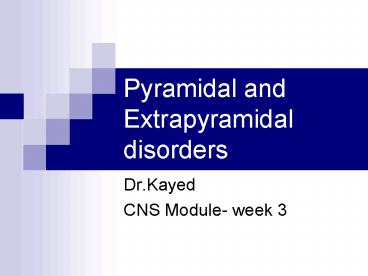Pyramidal and Extrapyramidal disorders - PowerPoint PPT Presentation
1 / 22
Title:
Pyramidal and Extrapyramidal disorders
Description:
Pyramidal and Extrapyramidal disorders Dr.Kayed CNS Module- week 3 ... (Vermis; paleocerebellum) Eye movement disorders: Nystagmus; Vestibulo-ocular reflex ... – PowerPoint PPT presentation
Number of Views:1987
Avg rating:3.0/5.0
Title: Pyramidal and Extrapyramidal disorders
1
Pyramidal and Extrapyramidal disorders
- Dr.Kayed
- CNS Module- week 3
2
The pyramidal system
- Fibres pass downwards from the motor cortical
pre-central gyrus into the internal capsule, via
the corona radiata. In the internal capsule
fibres occupy the posterior third of the anterior
limb and the anterior two-thirds of the posterior
limb. - After descending through the internal capsule the
corticospinal tract runs in the cerebral
peduncles on the anterior apsect of the midbrain.
The immediate posterior relation is the
substantia nigra. - In the pons the fibres are scattered, but they
regroup to form the pyramids on the anterior
aspect of the medulla. - In the medulla most fibres decussate to form the
lateral corticospinal tract. Fibres that do not
decussate descend as the anterior corticospinal
tract.
3
(No Transcript)
4
Pyramidal tract disorder
- Pyramidal tract disorders is also known as upper
motor neuron syndrome that is caused by damage to
the descending motor pathways. - The patient presents with consistent motor signs
and symptoms - The Babinski sign
- Hypertonic Spasticity
- Clonus (oscillatory motor response to muscle
stretching) - Hypereflexia (the reflexes are exaggerated)
- A loss of the ability to perform fine movements
- Muscle wasting result from prolonged non-use of
the muscle
5
The Babinski sign
- The normal response in an adult to stroking the
sole of the foot is flexion of the big toe, and
often the other toes. Following damage to
descending upper motor neuron pathways, however,
this stimulus elicits extension of the big toe
and a fanning of the other toes
6
Spasticity
- Spasticity is increased muscle tone, that will
cause increase resistance to passive movement
that increases with applied force until there is
a sudden give at a certain tension. - Spasticity is probably caused by the removal of
inhibitory influences exerted by the cortex on
the postural centers of the vestibular nuclei and
reticular formation
7
Clonus
8
A loss of the ability to perform fine movements
- If the lesion involves the descending pathways
that control the lower motor neurons to the upper
limbs, the ability to execute fine movements
(such as independent movements of the fingers) is
lost.
9
Extra-pyramidal system
- All fibers that influence the motor activity
without passing through the pryamidal tract - Cortex
- Basal Ganglia (caudate, putamen, globus pallidus,
Subthalamic nucleus and substantia nigra) - Thalamus
- Cerebellum
- Red nucleus
- Reticular nucleus
10
The function of the Extra-pyramidal system
Function Dysfunction
1. Regulation and integration of voluntary motor activity Involuntary motor activity rhythmic regular (static tremor) Dysrhythmic and irregular (chorea, athetosis, dystonia)
2. Regulation and maintenance of muscle tone Hypertonia or rigidity
3. Regulation and maintenance of emotional associative movement Bradykinesia, mask face, infrequent blinking, loss of swinging during walking.
11
There are two main categories of Extra-pyramidal
disorders
- Akinetic rigid syndrome (Parkinsonism)
- Dyskinesias
- Tremor
- Chorea
- Myocolonus
- Tics
- Dystonia
12
Tremor
- Tremors is a rhythmic, involuntary, oscillatory
movement of body parts - It is the most common movement disorder.
13
Classification of tremor
- Tremors are classified as rest or action tremors.
- Rest tremor occurs when the affected body part is
completely supported against gravity. - Action tremors are produced by voluntary muscle
contraction. - postural, isometric, kinetic tremors.
14
(No Transcript)
15
Tremor syndromes
16
chorea
- Is continuous flow of involuntary irregular
movement. The movements are rapid, jerky, non
rhythmic and explosive that flit from portion of
the body to another in random sequence. - It affects limbs and face and caused by lesion in
caudate nucleus
17
Causes of chorea
- Causes
- Hereditary huntingtons disease
- Birth injury Kernicterus
- Rheumatic Sydenhams chorea
- Pregnancy chorea gravidarum
- Vasculitic
- Thyrotoxicosis
- Drugs L-Dopa
18
Athetosis
- repetitive involuntary, slow, sinuous, writhing
movements, which are especially severe in the
hands. There are also elements of postural
disturbance. Usually combined with chorea known
as chorea-athetosis
19
Dystonia
- Involuntary, twisting, sustained movement of the
limb or head resulting in an abnormal posture.
20
Myoclonus
- Brief, isolated, involuntary, random, jerk
movement of a group of muscles. Intermittent with
distinct pause between each movement.
21
Tics
- Repetitive, stereotyped, semipurposeful movement.
- Patient could willingly suppress them at expense
of mounting inner tension - There are 2 types of tics
- Simple tics of children transient or chronic
- Complex tics Gilles de La Tourette syndrome
(tics, vocalization, obsessive behavior)
22
CEREBELLAR DYSFUNCTION
Cerebellar lesion Signs
Posterior(Flocculo-nodular lobe Archicerebellum) Eye movement disorders Nystagmus Vestibulo-ocular reflex (VOR)Postural and gait dysfunction
Midline(Vermis paleocerebellum) Truncal gait ataxia
Hemisphere(Neocerebellum) Limb ataxia Dysmetria, Dysdiadochokinesis, "intention" tremor Dysarthria Hypotonia































